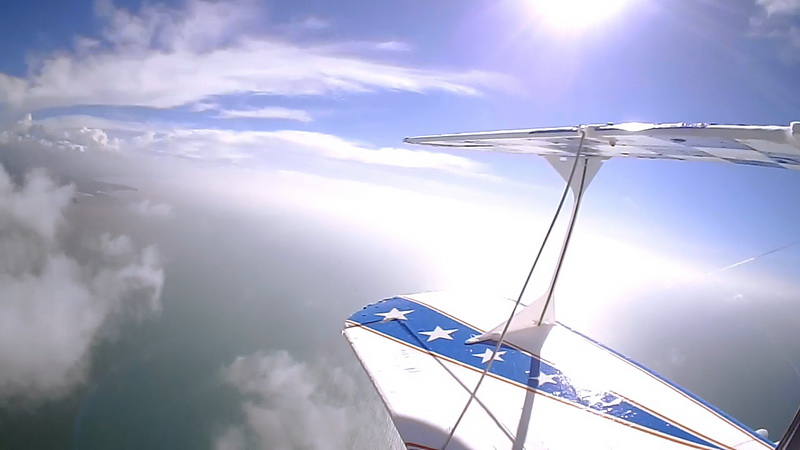
About
 The PITTS SPECIAL is Park Flyer grade airframe most popularly enjoy by VLOS flyer around the club field or designed to fly around small park. Mini size frame, dual wing spanned at 860mm powered using small 1300mah
The PITTS SPECIAL is Park Flyer grade airframe most popularly enjoy by VLOS flyer around the club field or designed to fly around small park. Mini size frame, dual wing spanned at 860mm powered using small 1300mah  3s 35c min. Just like my P-51D Mustang it is originally manufactured by ART-TECH sold the model as "Pitts Special" as RTF. Re-branded version available at HobbyKing.com as PNF which slash the price by half making it more affordable but some nice scale decals are missing and extra Hobby King label are stamped on the back fuselage which user can manually removed easily by peeling using double tape stickies. The other side of the rudder have been printed/labeled as STIIPS instead of PITTS which is well commonly taunted by R/c community a way to indicated if you've purchase a particular model of from Hobbyking.com. Regardless of cosmetic issues the platform indeed is fun to fly and bulk of performance package out of the box.
3s 35c min. Just like my P-51D Mustang it is originally manufactured by ART-TECH sold the model as "Pitts Special" as RTF. Re-branded version available at HobbyKing.com as PNF which slash the price by half making it more affordable but some nice scale decals are missing and extra Hobby King label are stamped on the back fuselage which user can manually removed easily by peeling using double tape stickies. The other side of the rudder have been printed/labeled as STIIPS instead of PITTS which is well commonly taunted by R/c community a way to indicated if you've purchase a particular model of from Hobbyking.com. Regardless of cosmetic issues the platform indeed is fun to fly and bulk of performance package out of the box.
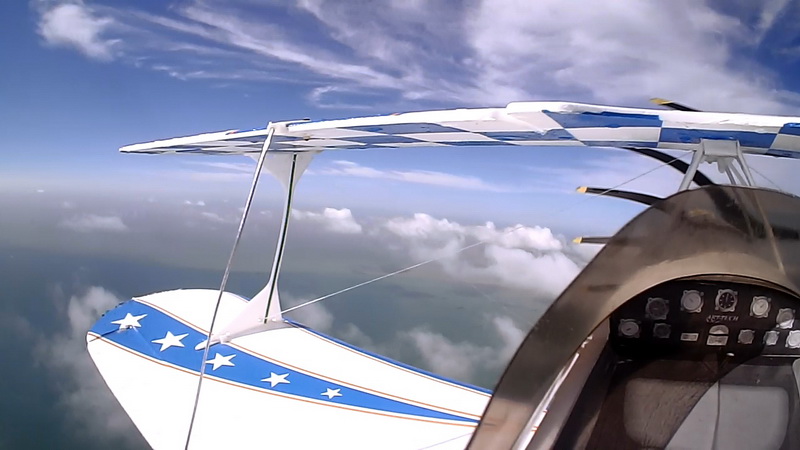
 Model specification & setup
Model specification & setup
Airframe type: Scale bi-plane - Aerobatic/Stunts
Branding/Manufacturer: ART-TECH/Hobby King
Model name variant: Pitts Special
Material build: EPS foam
Wingspan: 860mm
Length: 760mm
Stock airframe weight: 540 gram
Full FPV flying weight: 725 gram
Aileron: 1x 9g servo
Elevator: 1x 9g servo
Rudder: 1x 9g servo
ESC: 30A
Motor: DAT700/700KV (3s)
External BEC: 5A/5V
Propeller: 4 blade 10x8" scaled "HAMILTON STANDARD" replica
Radio receiver: Frsky telemetry 8ch
Radio receiver antenna: diversified DIY di-pole antenna  Battery: 1x 2200mah 2s~3s 25c
Battery: 1x 2200mah 2s~3s 25c
Center Gravity: 1/3 from the 1st top front leading edge of the wing (first mid plastic bolt).
My DIY FPV specification
Camera: 808 #16 V2 HD with live video out
Secondary camera: None
Camera pan/tilt mechanism: 9g HXT900 (180 deg mods)
OSD: Arkbird OSD/RTH/GPS V2
Flight Control board: Arkbird OSD/RTH/GPS V2
Video transmitter: Boscam 5.8ghz
Video antenna: DIY tuned Clover Leaf
Battery: Shared with main.
Building
 The Pitts have the most spacious airy internal fuselage cavity among all my FPV fleet. I can fit almost everything inside the fuselage an still remain 50% spacious for future add-on but it does has total
The Pitts have the most spacious airy internal fuselage cavity among all my FPV fleet. I can fit almost everything inside the fuselage an still remain 50% spacious for future add-on but it does has total  flight weight limit recommended below 750gram for performance flight factor. Originally stock fits 1300mah 3s lipo for normal LOS park flying but R/c community modders able to fly it on 2200mah 3s 25c flawlessly on stock ESC with extra 1.2kg of thrust power from APC type prop ranging from 11x7 to 12x6 2 blade propeller or my choice on 4x bladed DURAFLY "Hamilton Standard" scale props. The 2200mah pack slotted on 2nd largest mid bracket with its upper ceiling removed to be able to slide the pack 45 degree tilted towards the motor mounting firewall which resulted perfect 100% spot on CG.
flight weight limit recommended below 750gram for performance flight factor. Originally stock fits 1300mah 3s lipo for normal LOS park flying but R/c community modders able to fly it on 2200mah 3s 25c flawlessly on stock ESC with extra 1.2kg of thrust power from APC type prop ranging from 11x7 to 12x6 2 blade propeller or my choice on 4x bladed DURAFLY "Hamilton Standard" scale props. The 2200mah pack slotted on 2nd largest mid bracket with its upper ceiling removed to be able to slide the pack 45 degree tilted towards the motor mounting firewall which resulted perfect 100% spot on CG.
Just like Drifter Ultralight this Pitts also installed with ARKBIRD OSD/GPS/RTH as my fail safe and insurance against signal loss or anything beyond my control since i like to fly long distance. This system will take control semi, autonomously flight or autopilot moments if radio and video signal are lost and make a "U-turn" back to my control.
FPV building level difficulty/rating: Hard/Advanced (2/10)
FPV equipment setup grade: Professional
Building hours required: 58 hours
Skill required: Soldering/Foam cutting
Critical issues during installation: Keeping the weight to minimal.
Required additional mods/must do improvement: Beef up the motor mounting and propeller balancing.
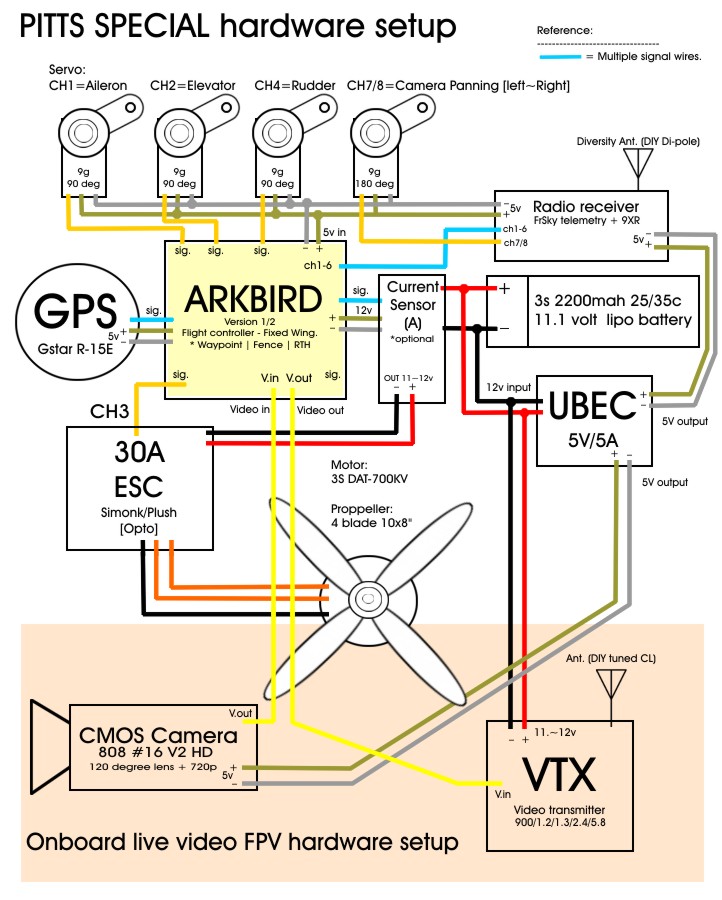

FPV flight characteristic and performance
 The Pitts inherit 50% both flying characteristic of my Drifter Ultralight and 50% of P-51D
The Pitts inherit 50% both flying characteristic of my Drifter Ultralight and 50% of P-51D  Mustang with natural build for extreme maneuverability, movement flexibility and 360 agility. Short stubby wings for sensitive roll and bi-winged for extra lift.
Mustang with natural build for extreme maneuverability, movement flexibility and 360 agility. Short stubby wings for sensitive roll and bi-winged for extra lift.
Just like the P-51D Mustang this platform is not for those who just graduated from standard FPV flight, its best for second ownership after his or her first "scale" FPV platform such as the P-51D, a PC-9 Pilatus, any low winged front tractor type plane or at least earn a few hours on Super Cub. The aura of FPV flying is completely different than conventional FPV glider. Since i'm flying like what real pilot does in cockpit seating position; the view are very restricted especially the frontal nose obstruction, ground viewing is limited, judging the AOA level is difficult, difficult to take-off & land, unpredictable "sink-rate" and ground proximity flight very challenging. The front Bi-wing and huge cowling make forward flight visibility almost impossible to view. Its all about in-cockpit skills from here.
Minimum level of VLOS flight experience required/flight-hours: Advance(570 hour)
Minimum level of basic FPV flight experience required/flight-hours: Intermediate (215 hour)
Nature of platform handling experience/skill required: Glider, scale and acrobatic flight(Professional)
Self leveling capability in thumbs-off stick situation: No (Required experience skills/airspeed judgment to properly level)
Take-off & landing difficulty: Medium
Hand launch: No Max speed: 78~km/h
Max speed: 78~km/h
Min speed before stall: 10~15km/h
FPV flight/radius: 4~8km max (given above FPV spec/setup)
Max altitude: -
Bail-out/fail safe recovery altitude limit: 30~35m
FPV safe distance range for testing: 400~900m (Open field)
High angle of attack (AOA) tolerance limit before stall: Not applicable.
Ground "STOL" (Short Take Off and Landing) capability/thrust%: Takeoff 8m (85%)/ Landing 3m (20%)
Altitude climbing power/thrust%/AOA angle: 1 sec/per-meter at 75% thrust/60 degree
360 degree turning radius clearance/holding pattern: 5m
360 barrel roll/loop acro flight: Yes (Aerobatic)
Control expo - aileron: 55% (low to high)
Control expo - elevator: 45% (low to high)
Control expo - rudder: 45% (low to high)
Control end point - aileron: 65% (low to high)
Control end point - elevator: 100% (low to high)
Control end point - rudder: 100% (low to high)
Flight time: 25~35 min
Ground spotter visibility (LOS): 300~400m
Safety issue
 Based on my experience on failed power incident the PITTS SPECIAL surprisingly able to glide at "sink-rate" behavior allowing it to "S.T.O.L" on its belly at very slow speed averaging 10-20km to the ground provided it was configured CG slightly nose heavy and flying weight best below 650gram. Its ability to float mostly contributed to its lightweight brittle EPS foam. The only similar platform that have nice gliding and slow belly "plop" such as this is my old FPV: ART-TECH COOTA because both of them have similar under carriage curve shaped belly which allow smooth belly glide.
Based on my experience on failed power incident the PITTS SPECIAL surprisingly able to glide at "sink-rate" behavior allowing it to "S.T.O.L" on its belly at very slow speed averaging 10-20km to the ground provided it was configured CG slightly nose heavy and flying weight best below 650gram. Its ability to float mostly contributed to its lightweight brittle EPS foam. The only similar platform that have nice gliding and slow belly "plop" such as this is my old FPV: ART-TECH COOTA because both of them have similar under carriage curve shaped belly which allow smooth belly glide.
Pros and Cons
Here are list of pros and cons about this platform. Some of this are needed to take seriously if you are going deep into long term FPV ambition
Pros:
- Extremely lightweight airframe.
- Relaxing and floaty at extremely low speed at almost landing S.T.O.L speed.
- Excellent power to weight ratio. 1.2kg worth tractor pull/acceleration/thrust power.
- Anti "Spiral of Death", quick stall bail out. Good flat spin control.
- Flexible control, aerobatic and maneuverability, good heat dissipation and RF clearance.
- Huge fuselage cavity of ease FPV hardware fittings.
- High rudder authority.
- Excellent undercarriage clearance for L.O.S antenna placement.
- Small, portable and easy to dismantle the wings for packaging/travelling portability.
- Huge control envelop capable of 360 degree sharp maneuvers.
- Highly hover-able almost 0~1km when pickup by steady or heavy winds.
- Tractor type propeller viewable from behind allow better visual throttle timing adjustment and trimming to synchronize required endurance and reserve power.
Cons:
- Does not self leveling the wings and nose angle regardless even if artificially or electronically a
 ssisted, will need constant pilot control and flight judgment.
ssisted, will need constant pilot control and flight judgment. - Confusing nose AOA (Angle Of Attack) due to airframe layout.
- OSD with AHI indicator and Altimeter are highly recommended.
- Un-noticable "Sink-rate".
- Originally a tail heavy frame.
- Sensitive aileron control for trade with maneuverability.
- Forward viewing is impossible. Low visibility flight inside the cockpit. 35~50% of useful in flight FPV view, especially when during low altitude flight, ground tracking and landing. Need to see where you going through side windows which is awkward for general FPV pilot. However this FPV is fall in the category of "Scale FPV piloting"... fly it like a real plane.
- In some situation where visibility is bad ILS flight play a vital role, your pocket burner OSD is going to be your best friend throughout the flight.
- Airframe have extremely high and sensitive roll rate (direct center roll CG), you're more likely to roll more during lost orientation or moment of low visibility when there no horizon to indicate your axis leveling.
- Eminent high propeller vibration. Huge motor cowling, huge fuselage design and brittle EPS foam factor amplifying any vibration emitted from the huge radial motor through the motor echoing throughout the airframe regardless after huge effort to balance the propeller. Soft GWS (SF) 4 blade type will remedy the problem but will cut the thrust power by half and reduce flight performance which is not advisable. Going 2 blade will be a disaster choice for FPV especially hard APC type.
- Putting a Go-pro is equivalent of putting a concrete brick, Go-pro is a no Go.
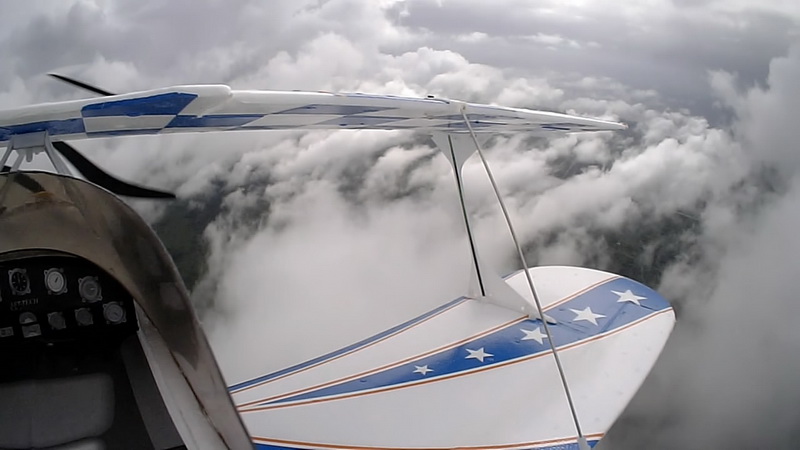
Current status & flight history
 The reason my i like to fly the PITTS SPECIAL as scale FPV platform because i like "Classic" feeling of flying a bi-winged plane cross country giving the epic classic 30's~40's mood behind the cockpit. Watching the bi-wings, moving ailerons, huge cowling, passes the ocean, rivers and land mass below the wings are most golden moment for any pilot want to be. The airframe already flown handful hours of VLOS aerobatic flight before converted into FPV platform. It has been through 3 stages of builds
The reason my i like to fly the PITTS SPECIAL as scale FPV platform because i like "Classic" feeling of flying a bi-winged plane cross country giving the epic classic 30's~40's mood behind the cockpit. Watching the bi-wings, moving ailerons, huge cowling, passes the ocean, rivers and land mass below the wings are most golden moment for any pilot want to be. The airframe already flown handful hours of VLOS aerobatic flight before converted into FPV platform. It has been through 3 stages of builds  throughout its flight operation which concern more on weight reduction and its handling. Endurance has improve further beyond FPV community expectation. Like the P-51D Mustang the Pitts best suited to fly in big open area outside populated area such as over large bodies of ocean, river and open fields clear from aviation traffic, thus where Pitts are photogenicaly blends right with the open environment. One of the things that annoys me during the flight is the vibration emitted from the propeller to the motor and amplified more by its huge firewall and cowlings as mentioned before thus spoils the overall HD videos on board. I only bring out the Pitts only if there's a huge steady or heavy winds gushes from the sea because the Pitts works 100% better in windy environment making take off, landing, hovering, altitude climbing and gliding an easy flight. Pitts comes in third place among my FPV fleet when it comes to LRS (Long Range Flight) flight which best maxxed straight line distance of 8km or 16km flight diameter radius provided linked to ground station, tracker, telemetry tracking, patches and diversity radio are present.
throughout its flight operation which concern more on weight reduction and its handling. Endurance has improve further beyond FPV community expectation. Like the P-51D Mustang the Pitts best suited to fly in big open area outside populated area such as over large bodies of ocean, river and open fields clear from aviation traffic, thus where Pitts are photogenicaly blends right with the open environment. One of the things that annoys me during the flight is the vibration emitted from the propeller to the motor and amplified more by its huge firewall and cowlings as mentioned before thus spoils the overall HD videos on board. I only bring out the Pitts only if there's a huge steady or heavy winds gushes from the sea because the Pitts works 100% better in windy environment making take off, landing, hovering, altitude climbing and gliding an easy flight. Pitts comes in third place among my FPV fleet when it comes to LRS (Long Range Flight) flight which best maxxed straight line distance of 8km or 16km flight diameter radius provided linked to ground station, tracker, telemetry tracking, patches and diversity radio are present.
Lifespan operation: 3 years (updated on 19 June 2015) Start operation: mid 2012
Start operation: mid 2012
Maintenance priority check: Motor mounting
Constant critical issue: None
Maintenance cost per-lifespan: None
Flight hours accumulated per-lifespan: 450 hours (updated on 19 June 2015)
Best L.O.S distance record: 10km (updated on 19 June 2015)
Est. distance covered per-lifespan: 10,853km (Odo)(updated on 19 June 2015)
Best height record: -
Best flight time record per-session: 45min (2200mah 3s 35C)
Best low hovering speed record: 5km/h
Best record for zero thrust landing distance/power failure glide recovery distance: Success landing at glide speed from failure distance 1.3km/320m elevation (ESC sync problem).
Activity status: Still active.
Summary

 Pitts Special has an extremely small airframe not a standard size nor something that any FPV enthusiast anticipated about. However for a FPV pilot seeking a new FPV frontier and challenges might give this little guy a try, plus i have proven it does well on long range FPV flight placing its foot print between the border of FPV and UAV shoes.
Pitts Special has an extremely small airframe not a standard size nor something that any FPV enthusiast anticipated about. However for a FPV pilot seeking a new FPV frontier and challenges might give this little guy a try, plus i have proven it does well on long range FPV flight placing its foot print between the border of FPV and UAV shoes.
Flying inside the cockpit seat of PITTS SPECIAL can best described as Classically Epic, beautiful and also give a huge WOW factor to the audience. It give the expression of being adventurous flying of the 40's theme. Viewable wing structure, engine cowlings and rush of clouds beneath the wings making it the most exotic scale FPV experience in history of FPV flights. The plane itself is a beauty both in and out, exhibit a great shelf queen inside your home too. If you intend to put a Go-Pro then you better start digging its grave, the happy ending will ends in 3, 2 1..."plop!".
Anyone who really wants to fly this as a scale FPV platform will serious need do to his/her homework intensively first. Lots of research, earn VLOS generic aerobatic skills and hours of standard FPV flight is essential to build up flight "common sense" in r/c flying because the PITTS is a wild stallion at unpredictable situation and it always keeps your hands fully occupied just like how you'd feel when you fly a 6ch 450 size helicopter.
Just like the P-51D Mustang, if you've successfully flown PITTS SPECIAL in scaled manner along with hours of scale flight experience and always back in one piece without a scratch then you're definitely reached the pinnacle of FPV karma.
Videos/Medias![]() Here are some of my video and gallery related to the above topics:
Here are some of my video and gallery related to the above topics:
- Gallery: Pitts Special - 860mm
- My Youtube channel: 3DXL
- My Videos:
- FPV Pitts Special - Power Clouds (2023)
- FPV Pitts Special, Cloud Punch 2016
- FPV Pitts Special - Dusky New Year Sky (2023)
- FPV Pitts Special - 3rd year of great cloud surfing anniversary 2015
- FPV Pitts Special, Sunrise Clouds
- FPV Pitts Special - Wing camera setup
- FPV Pitts Special - Turbulent Wind II
- FPV Drifter Ultralight - Turbulent wind
- FPV Pitts Special - "Selfie" style
- FPV Pitts Special - Cloud Walker
- FPV test flight - Pitts Special V3 over the clouds (Reloaded)
- FPV Pitts - Beautiful Adventure
- FPV Pitts Special - Cold Slumber flight
- FPV flights on Pitts Special bi-wing
- Pitts Special aerobatic flight
Shopping list
 Here I've listed some raw material, hardware and stuff where you can start building your own FPV platform. The list contain the above hardware and also include some compatible ones which you can pickup what suits best for your need and your budget. So come dig around and start your tech flying ambition:
Here I've listed some raw material, hardware and stuff where you can start building your own FPV platform. The list contain the above hardware and also include some compatible ones which you can pickup what suits best for your need and your budget. So come dig around and start your tech flying ambition:
- Platform/Airframe:
- Radio set/combo:
- Flysky TH9x combo (Mode 1)
- Flysky TH9x combo (Mode 2)
- Turnigy 9X combo (Mode 1)
- Turnigy 9X combo (Mode 2)
- FrSKY TARANIS X9D ACCST 2.4ghz transmitter version B
- FrSky DHT 8CH DIY compatible telemetry transmitter module (Advance installation required)
- Frsky V8FR-II 2.4ghz 8ch receiver HV version
- Frsky V8R7-II 2.4ghz 8ch receiver
- Motor/ESC/BEC:
- Servo:
- E-MAX ES08MA analog metal micro servo
- TOWER PRO SG90 micro servo 9g (Most popular among r/c plane builder similar to HXT900 servo)
- TOWER PRO MG995 metal geared micro servo 9g
- TOWER PRO SG90S metal geared micro servo 9g
- E-MAX ES3154 mini
- VWINRC MG90D metal gear servo 9g
- E-MAX ES08MA analog metal gear micro servo
- Camera/HD/DVR:
- FPV 800TVL mini CMOS NTSC
- 520TVL CMOS nano (Excellent for micro/nano size FPV platform)
- 600TVL CMOS nano (Excellent for micro/nano size FPV platform)
- Keychain 808 #16 V1 HD camera
- Keychain 808 #16 V3 HD (With live output and HD recording, most popular among r/c and FPV use)
- 1/3 600TVL CMOS NTSC (Best on mini 200 size FPV platform with advantage of generic interchangeable lens)
- 1/3 600TVL CMOS PAL (Best on mini 200 size FPV platform with advantage of generic interchangeable lens)
- FATSHARK 1/3 600TVL CMOS NTSC/PAL (Best on mini 200 size FPV platform with advantage of generic interchangeable lens)
- BOSCAM HD19 Plus Explorer Full 1080p RC Aerial Photography FPV camera
- Mobius 1080p HD (Excellent quality)
- Y3000 720p HD mini (Super lightweight)
- Flight controller/AP System/OSD:
- FEIYU TECH FY 41AP Lite autopilot (Quick Plug N Fly autopilot system)
- REMZIBI OSD v1.79 GPS (Small enough to fit into any plane and give accurate measurement)
- Simple 3-axis flight stabilizer for airplane
- SKYLARK FPV OSD with GPS
- SKYLARK Dianmu OSD with GPS and Barometer
- APM 2.5.2 flight board (For advance ARDUINO user)
- APM 2.6 flight board (For advance ARDUINO user)
- APM 2.6 with GPS (For advance ARDUINO user and extended autonomous flight)
- APM 2.6 with GPS + OSD + radio telemetry system (For advance ARDUINO user and extended autonomous flight)
- PIXHAWK 2.3 flight controller ATM32F4 APM PX4 (For advance ARDUINO user and extended autonomous flight)
- RCD 3060/Simple OSD (Super budget)
- MWC Mega 3.0 MegapirateNG flight controller (For advance ARDUINO user and most popular for budget open source use)
- HK G-OSDIII with GPS (Budget but not all that accurate gauge)
- ARKBIRD OSD/GPS Autopilot system (Excellent for fixed winged)
- ARKBIRD Tiny bakancer/stabilizer controller board for fixed winged plane
- Video transmitter/combo:
- BOSCAM 2.4ghz 500mw transmitter + receiver (Better obstacle penetration but recomended your radio controller uses other than 2.4ghz to avoid conflict)
- BOSCAM 5.8ghz 200mw transmiter (Basic)
- BOSCAM 5.8Ghz 400w transmitter
- BOSCAM 5.8ghz 8ch receiver
- BOSCAM 5.8Ghz 400w transmitter + receiver combo
- BOSCAM 5.8ghz 600mw transmitter 32ch (Medium range)
- BOSCAM 5.8ghz 600mw transmitter + receiver combo 32ch (Medium range)
- BOSCAM RC305 8ch wireless Audio/Video receiver (Basic requirement for 5.8ghz)
- BOSCAM 5.8ghz 200mw transmitter + receiver combo pack
- BOSCAM AIO FPV video goggle GS920 with receiver 2.4ghz/5.8ghz (Excellent for serious FPV flyer)
- BOSCAM AIO FPV video goggle GS922 with diversified receiver and built-in DVR
- SKYZONE SKY-01 FPV video goggle with receiver 5.8ghz diversity antenna build-in (Excellent for serious FPV flyer)
- SKYZONE SKY-700D FPV 5.8ghz 32ch monitor + DVR (Excellent for starter and complete DVR combo)
- SKYZONE RC702 SKY-702 5.8ghz 7" AIO diversity receiver monitor
- FPV 7" TFT LCD monitor 800x480 screen with audio (Excellent for budget beginner DIY FPV build)
- FATSHARK Predator V2 FPV video goggle complete combo package (Popular choice but only works with FATSHARK video/audio transmitter compatibles)
- FATSHARK Teleporter V3 FPV video goggle complete combo package HD (Popular choice but only works with FATSHARK video/audio transmitter compatibles)
- FATSHARK DOMINATOR FPV video goggle (Excellent for expert/performance DIY FPV system)
- FATSHARK BASE HD (Popular customizable choice but only works with FATSHARK video/audio transmitter compatibles)
- Battery:
- YKS 2200mah 3s 25c 11.1v
- High rate 2200mah 3s 25c 11.1v
- High rate 2200mah 3s 35c 11.1v
- WILD SCORPION 2200mah 3s 30c 11.1v
- WILD SCORPION 2200mah 3s 35c 11.1v
- ACE 2200mah 3s 20c 11.1v (Really good performance)
- ACE 2200mah 3s 25c 11.1v (Really good performance)
- ACE 2200mah 3s 30c 11.1v (Really good performance)
- LION POWER 2200mah 3s 25c 11.1v
- LION POWER 2200mah 3s 30c 11.1v
- LION POWER 2200mah 3s 35c 11.1v
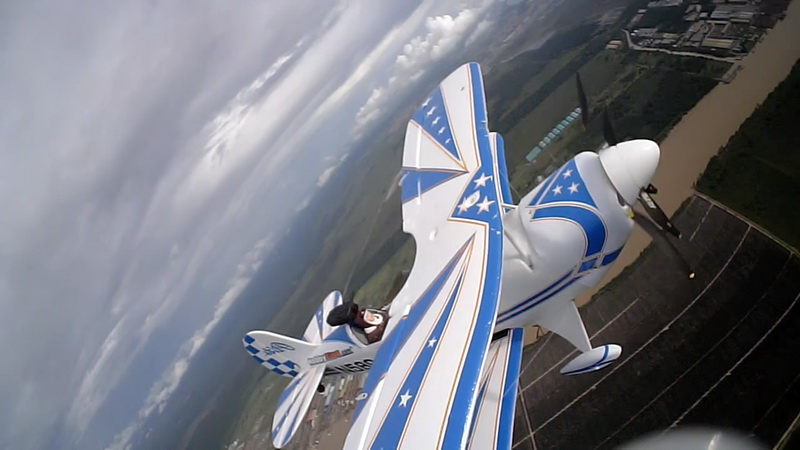
Building threads/Referral
If you don't know where to begin with i recommend you to start reading some guides, wikis and building tips from popular on-line resources as listed below. You might find me hanging around some popular R/C and FPV forum below.
- Rcgroups Scale model FPV build discussion
- Rcgroups FPV forum
- http://www.rcgroups.com
- http://www.fpvlab.com
- http://www.diydrones.com
- http://www.rcuniverse.com
- http://www.flitetest.com
- http://fpv-forum.com
- http://www.rcexplorer.se
- http://homepages.paradise.net.nz/bhabbott/Servo.html
